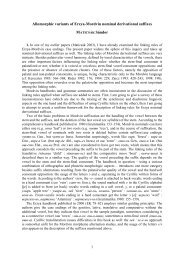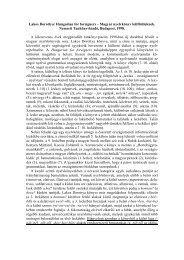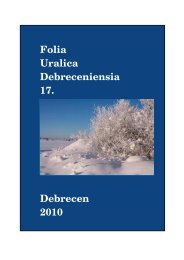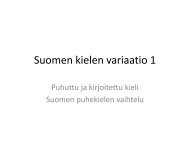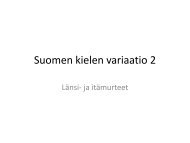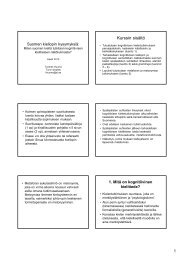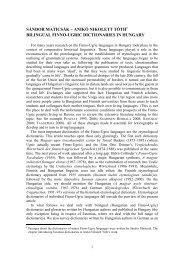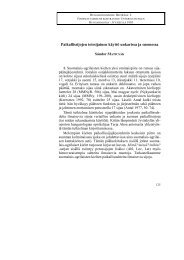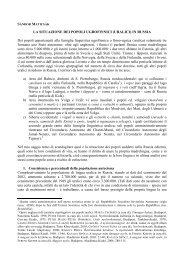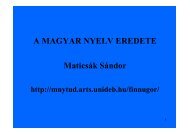folia uralica debreceniensia 19. - Finnugor Nyelvtudományi Tanszék
folia uralica debreceniensia 19. - Finnugor Nyelvtudományi Tanszék
folia uralica debreceniensia 19. - Finnugor Nyelvtudományi Tanszék
Create successful ePaper yourself
Turn your PDF publications into a flip-book with our unique Google optimized e-Paper software.
ISMERTETÉSEK – REZENSIONEN – REVIEWS – KATSAUKSIA – РЕЦЕНЗИИ<br />
During her first trip to Moldavia, Isohookana-Asunmaa was surprised by<br />
the lack of any linguistic rights of the Csángós and by the general negative<br />
attitude towards the Csángós by the local municipality officials, schools and<br />
vicars. She became convinced on the need for international protection when<br />
she experienced the discrimination on the field. She was shocked to find out,<br />
for instance, how the Csángó children were routinely considered as having<br />
lower IQ by the local teachers and school administration.<br />
The European Council recommendation 1521 (2001) calls for the recognition<br />
of the culture and language of the Moldavian Csángós as an exceptional<br />
value for Europe. It requests Romania to ensure the linguistic rights of<br />
the Csángós in education and religious services. This recommendation has<br />
resulted to the teaching of Hungarian in more than 20 villages in Moldavia.<br />
However, despite of the efforts of Isohookana-Asunmaa and others, the Catholic<br />
Church in Moldavia is still insisting on having its services only in Romanian.<br />
The book documents the Csángós as an archaic culture, with rich folk<br />
traditions, for instance, in music. The many illustrations show the colorful<br />
folk costumes and textiles of the Csángós. The image of the Csángós that is<br />
constructed in the book is that of a cultural relic. Modernity, in turn is presented<br />
in negative terms. Beyond discriminatory acts by the Romanian state,<br />
local authorities and clergy, modernity is blamed in general for the dwindling<br />
of the traditional values, customs and knowledge of the archaic version of the<br />
Hungarian language. Globalization in turn, has resulted in the migration of<br />
the Csángó youth to the Mediterranean countries and the returnees have<br />
brought West European habits to Moldavia. A return to the traditions in the<br />
spirit of ethnofuturism and a revitalization of the Csángó language with promoting<br />
its literary use are proposed as solution for the cultural survival of the<br />
Csángós. However, the new possibilities brought by modernity are not discussed.<br />
In the view of Isohookana-Asunmaa and the European Council recommendation,<br />
the Csángós have a distinct, even though not homogenous, culture<br />
and language. The idea of a distinct, autonomous Csángó language has<br />
been rejected by the mainstream of Hungarian linguists. However, according<br />
to the recommendation, the endangered Csángó language should be protected.<br />
In political terms, this is understandable, since the Hungarian language<br />
is not in need of protection from extinction. Furthermore, the idea of<br />
protecting or revitalizing dialects is still rather new even among the activists<br />
of linguistic rights, not to mention politicians or mainstream linguists.<br />
224



